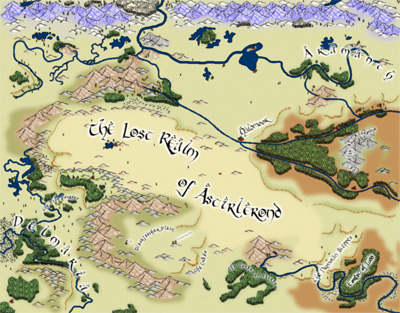ralf | November 1, 2021 | Annual, overland maps, Pete Fenlon
 The November issue of the Cartographer’s Annual 2021 includes the “Pete Fenlon Revisited” style pack, where we extensively re-worked the 2008 map style based on the iconic maps of ICE’s maps for the Middle-earth roleplaying game.
The November issue of the Cartographer’s Annual 2021 includes the “Pete Fenlon Revisited” style pack, where we extensively re-worked the 2008 map style based on the iconic maps of ICE’s maps for the Middle-earth roleplaying game.
With the permission of Pete Fenlon, the author and artist of those maps, we produced a vector style pack in the second year of the Cartographer’s Annual. Since then CC3+ has been released and many new features and tools were added to Campaign Cartographer. To make use of these, we re-worked the templates and drawing tools and also took the opportunity to add more bitmap fills and symbols to the style.
More than 50 drawing tools and over 150 symbols now allow you to create overland maps in Pete Fenlon’s wonderful style much more quickly and easily. The 6-page mapping guide has also been re-written to account for all the new stuff.
The November issue is now available for all subscribers from their registration page. If you haven’t subscribed to the Annual 2021 yet, you can do so here.
2 Comments
Simon Rogers | June 10, 2011 | overland, Pete Fenlon
Our Annuals are designed to give value year after year – as an example, I give this flashback to May 2008 from my livejournal…
Many of us remember, and were inspired by Pete Fenlon’s wonderful maps for the Middle Earth Roleplaying Game. Today, Pete is Chairman and Studio Director at Mayfair Games. In January 2008, with Pete’s permission we released a style pack for making maps in his style as part of the Cartographer’s Annual 2008.
Steve Townshend produced this beautiful map in the Pete Fenlon style.

It uses only specially designed vector symbols combined with CC3’s effects to get the right look.
Style packs are preconfigured so that if you select a tool (for example, rivers, roads and terrain), it looks right for the map style. To create a forest, you just select the forest draw tool, click points for the border, and it does this, adding random tree tops and edge trees.

You building up mountain ranges by selecting a symbol, then placing. They are selected randomly from a collection of symbols. So this was one click per mountain, and the mess at the bottom is a mountain cursor. You can tab through random styles if you don’t like the current mountain at the cursor.

The distinctive ridges are also built up of symbols. On the left, with CC3 effects off, on the right, with them on.


Although the styles definitely make it easier to create maps such as these, Steve Townshend demonstrates that the human touch is still required to get an aesthetically pleasing map – style packs just make it easier to get the desired effect.
You can download the map in CC3 format here.
4 Comments
 The November issue of the Cartographer’s Annual 2021 includes the “Pete Fenlon Revisited” style pack, where we extensively re-worked the 2008 map style based on the iconic maps of ICE’s maps for the Middle-earth roleplaying game.
The November issue of the Cartographer’s Annual 2021 includes the “Pete Fenlon Revisited” style pack, where we extensively re-worked the 2008 map style based on the iconic maps of ICE’s maps for the Middle-earth roleplaying game. 



